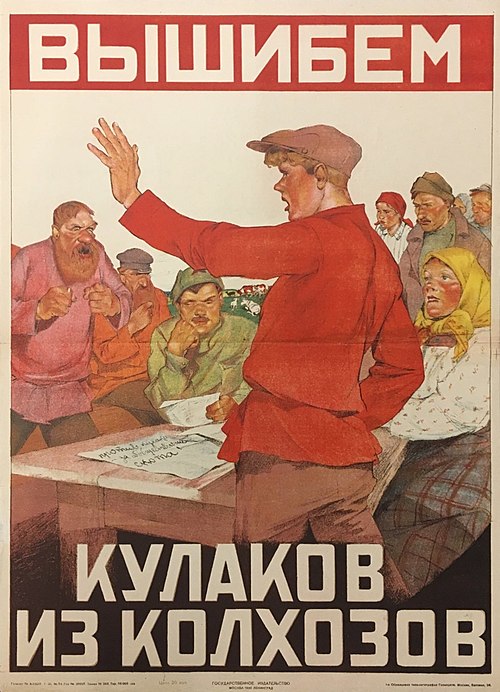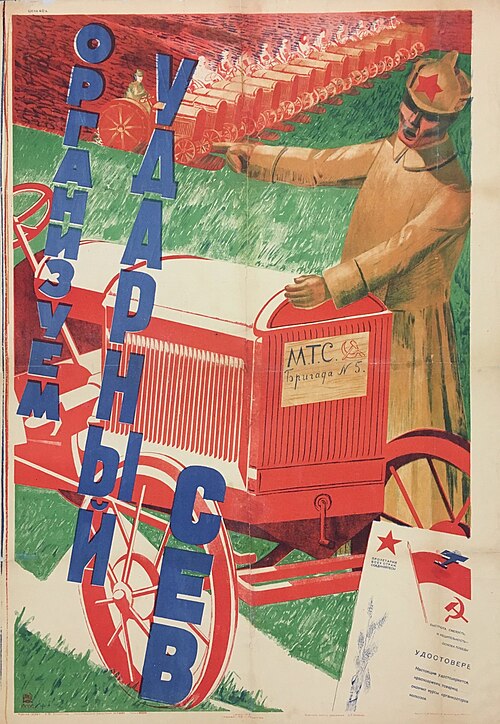OCR Specification focus:
‘economic policies in the 1930s, agriculture, kulaks, voluntary and forced collectivisation, mechanisation; industrialisation, Gosplan, first two Five Year Plans’
Stalin’s economic policies of the 1930s reshaped Soviet society through radical agricultural reforms, ambitious industrialisation, and the central planning system, aiming to modernise Russia into a superpower.
Agricultural Policies in the 1930s
Collectivisation of Agriculture
Stalin believed that modernising agriculture was essential to support industrialisation. The policy of collectivisation involved merging individual peasant farms into large, state-controlled collective farms known as kolkhozy and state farms known as sovkhozy.
Voluntary collectivisation (1928–1929): Initially presented as a voluntary process, but peasants were reluctant to give up their land, animals, and independence.
Forced collectivisation (1929 onwards): The state applied coercion, propaganda, and violence to achieve mass collectivisation, often through requisition squads.
Kulaks: Wealthier peasants who were targeted as class enemies of socialism and accused of hoarding grain or resisting collectivisation.
By 1931, collectivisation had become almost universal, with devastating consequences for rural life.
Dekulakisation and Resistance
The campaign against kulaks was brutal. They were dispossessed, deported, imprisoned, or executed. Resistance was widespread, with peasants slaughtering livestock rather than surrendering them. Between 1929 and 1933, the number of cattle, pigs, and horses fell drastically.

Poster (1930) urging the removal of kulaks from collective farms. It illustrates the class-enemy framing that legitimised confiscation and deportations during dekulakisation. As propaganda, it amplifies mobilisation rhetoric beyond the economic mechanics. Source
Mechanisation of Agriculture
To replace lost peasant labour and modernise farming, Stalin introduced mechanisation through Machine Tractor Stations (MTS). These state-run centres provided tractors and equipment to collective farms, allowing closer state control. However, shortages of machines and skilled operators limited effectiveness.

Poster (1930) advocating rapid, machine-led sowing on collective farms. The tractor embodies Machine Tractor Stations (MTS) delivering equipment and oversight to kolkhozy. As propaganda, it presents an idealised view that downplays resistance and shortfalls in machinery. Source
MTS ensured state oversight, as political commissars monitored collective farms.
Mechanisation remained patchy, and much of the work continued to rely on manual labour into the 1930s.
The Famine of 1932–1933
Collectivisation, requisitioning, and poor harvests contributed to widespread famine, particularly in Ukraine (Holodomor). Millions died, and food shortages devastated peasant communities. Despite this, the state exported grain to fund industrial development.
Industrialisation under Stalin
The Role of Gosplan
The Gosplan (State Planning Commission) was central to Stalin’s economic vision. It drew up targets and directives for industries across the USSR.
Gosplan: The Soviet State Planning Committee responsible for producing centralised economic plans, including the Five Year Plans, which directed industrial output and priorities.
Its targets were often unrealistic, but it played a crucial role in coordinating resources and driving industrial growth.
The First Five Year Plan (1928–1932)
The first plan aimed at rapid industrialisation with a focus on heavy industry.
Key features:
Enormous investment in coal, steel, iron, and electricity.
Construction of vast industrial complexes like Magnitogorsk.
Ambitious production targets, often far beyond achievable capacity.
Achievements:
Significant increases in coal and iron output.
Creation of a skilled industrial workforce.
Symbolic importance of “building socialism” through industry.
Limitations:
Widespread inefficiency, waste, and accidents.
Consumer goods industries neglected.
Harsh working conditions, with labour discipline enforced strictly.
The Second Five Year Plan (1933–1937)
The second plan consolidated gains of the first but also adjusted priorities.
Continued growth in heavy industry, with more realistic targets.
Greater attention to transport infrastructure, including the Moscow Metro.
Some expansion in consumer industries, though still limited.
Advances in engineering and metallurgy improved military capacity.
Achievements:
The USSR became largely self-sufficient in industrial production.
Urbanisation accelerated as millions moved from countryside to cities.
By the mid-1930s, the Soviet Union was on the path to becoming a global industrial power.
Shortcomings:
Persistent shortages of consumer goods.
Overemphasis on quantity over quality in production.
Harsh punishments for failing to meet targets encouraged falsification of results.
Social and Political Dimensions of Economic Policy
Impact on Workers
Industrialisation transformed the Soviet workforce. Millions of peasants became factory workers, experiencing strict discipline, harsh living conditions, and long hours.
Shock brigades and Stakhanovite movement encouraged workers to exceed quotas, sometimes unrealistically.
Propaganda celebrated industrial heroes while punishing “wreckers” accused of sabotage.
Impact on Peasants
The peasantry bore the heaviest burden of Stalin’s policies. Collectivisation destroyed the traditional village economy, and famine killed millions. Survivors were tied to collective farms with limited mobility.
Political Control through Economics
Economic policies were inseparable from political control. The state used collectivisation and industrialisation to strengthen the regime, eliminate opposition, and enforce loyalty through propaganda and coercion.
Peasants lost independence as collective farms became extensions of state power.
Workers were bound by labour laws that punished absenteeism and indiscipline.
Economic progress was presented as evidence of socialism’s triumph under Stalin.
Conclusion of Economic Transformation
Stalin’s economic policies of the 1930s—centred on collectivisation and industrialisation—were revolutionary in scale and impact. They caused immense suffering but transformed the USSR into an industrial power capable of confronting external threats.
FAQ
Propaganda was central in portraying collectivisation as a progressive and heroic endeavour. Posters and newspapers highlighted the benefits of modern machinery and collective effort.
The regime depicted kulaks as greedy exploiters, reinforcing the idea that removing them was a patriotic duty. Cultural tools like films and songs further glorified the move towards collective farms.
Women often bore the brunt of collectivisation. When men were deported as kulaks, women became the primary workforce on collective farms.
Many also joined the workforce in Machine Tractor Stations as operators or support staff, a shift that altered traditional gender roles in the countryside.
Magnitogorsk represented the ambitions of the First Five-Year Plan. Built from scratch, it became a vast steel-producing complex.
It symbolised both the triumphs and costs of Stalin’s policies: rapid growth in heavy industry, but also harsh working conditions, overcrowding, and reliance on foreign engineers in the early years.
The Stakhanovite movement, launched in 1935, celebrated individuals who massively over-fulfilled production quotas.
While some workers embraced the rewards and recognition, many resented the pressure it created. Complaints arose that unrealistic targets made conditions harsher, leading to tensions in the workforce.
Peasants often slaughtered livestock rather than hand them over to collective farms. This led to catastrophic declines:
Horses dropped from 34 million in 1929 to around 17 million by 1933.
Cattle fell from 70 million to 38 million in the same period.
These losses severely reduced agricultural productivity, undermining one of collectivisation’s stated goals.
Practice Questions
Question 1 (2 marks)
Name one way in which Machine Tractor Stations (MTS) were used to strengthen state control over Soviet agriculture.
Mark scheme:
1 mark for identifying a relevant use of MTS.
1 additional mark for a brief explanation or detail.
Acceptable answers include:
Provided tractors and machinery to collective farms (1) and placed political commissars on site to monitor peasants (1).
Ensured state supervision of collectivised agriculture (1) through direct control of farming equipment (1).
Question 2 (6 marks)
Explain two reasons why Stalin introduced collectivisation in the early 1930s.
Mark scheme:
Award up to 3 marks per reason.
1 mark for identifying a valid reason.
1 mark for providing supporting detail or explanation.
1 mark for linking it to the broader aims of Stalin’s policies.
Possible reasons include:
To secure grain supplies for the cities and to fund industrialisation (1), as grain requisitioning under the NEP was inadequate (1), ensuring resources for rapid industrial growth (1).
To destroy the independence of the peasantry (1), targeting kulaks as class enemies (1), thus extending state and Party control into the countryside (1).
To modernise agriculture (1), by introducing mechanisation through MTS (1), making farming more efficient and supporting industrial needs (1).
Maximum 6 marks.

